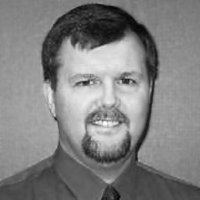Interview with Don Hayes, Ph.D., Director of Audiology, Unitron
Topic: uHear™ - iPhone™ and iPod touch® Hearing Screening Application
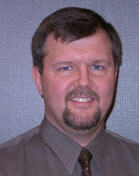
Don Hayes, Ph.D.
Carolyn Smaka: Today I'm speaking with Don Hayes, Director of Audiology for Unitron. Thank you for taking the time to speak to me today, Don.
Don Hayes: Thank you, Carolyn.
SMAKA: Before we start, can you tell me about your role at Unitron?
HAYES: I'm the Director of Audiology at the Unitron corporate office in Kitchener, Ontario, Canada. My group is mainly concerned with product validation. This means, when products are under development, we do validation work that includes fittings on people with hearing impairment, both in the corporate office and out in the field, to make sure that new products work as intended. We also collaborate with marketing communications. Anything you see in our marketing materials that is technical was probably originally written by one of our audiologists and vetted by marketing communications. My department is also responsible for training. We train Unitron staff around the world, and we also conduct training at places like AudiologyNow and at the EUHA congress in Germany.

SMAKA: Tell me how the uHear™ concept came about.
HAYES: Development of uHear began last December. The President & CEO of Unitron, Cameron Hay, called me into his office and said that he wanted Unitron to develop an application for iPod touch® an iPhones™ that could perform a basic hearing test. I walked out of his office and thought this sounded like a fun project.
Shortly after that meeting, I found myself in a room with Tom Auger from Zeitguys Inc. who created the interface, Simon Woodside who developed the code, and several product managers from Unitron. As ideas were bounced around, the job started to grow and excitement started to build. My role in the development of uHear was to design the way the hearing testing was performed in the application. We decided that the application would, of course, have pure tone threshold testing, but we also wanted to include other types of testing. We thought a speech-in-noise test would be an appropriate addition, and we chose to use a modified Acceptable Noise Level (ANL) test for that. We also put in a twelve question screening questionnaire called the Hearing Dependent Daily Activities (HDDA) Scale. So there are three different tests a person can choose to do to screen hearing. The software also has an aural rehab section that contains basic information on hearing loss, and gives communication strategies for people with and without hearing aids.
One nice thing about this application is that it doesn't stop at simply allowing users to perform hearing screenings on themselves;there is 'locate' function that helps them find the nearest hearing healthcare professional's office. The locator uses the WiFi capabilities of the iPod touch or iPhone device to determine where the person is at a given moment. If a person does a test and wants to take the next step and be seen by a professional, then it will actually give them complete contact information for the nearest 10 hearing professionals, and even provide a map with their locations noted.
Our goal is not to replace the audiologist and a hearing test in a sound treated booth. The goal of uHear is to direct the user to a qualified hearing healthcare professional. We make it abundantly clear that a hearing test done with an iPhone or iPod touch is not a comprehensive hearing test, which is why this is referred to as a screening test. The results will probably be in the ballpark of the patient's actual hearing, but it by no means replaces a qualified hearing healthcare professional and calibrated equipment. The emphasis is always on going back to the hearing healthcare professional to follow up on the results of the uHear's™ screening. This is stated in multiple places in the application in order to keep the focus on visiting a hearing healthcare professional.
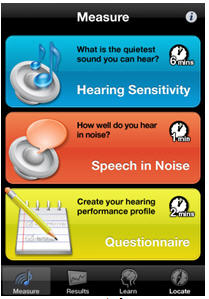
uHear is comprised of 4 sections: Measure, Results, Learn and Locate
SMAKA: You mentioned the aural rehab section of the application, and many of the reviews I read on iTunes said that section is extremely helpful.
HAYES: Yes, the section entitled "Learn" is intended to give general information regarding hearing loss and communication strategies. These tips are not just what Unitron says to do, but they have been gathered from several resources. Some of them come from the Better Hearing Institute website, www.betterhearing.org, the World Health Organization, and others came from Aural Rehabilitation textbooks and journal articles. We wanted to make sure that the information found in the application was factual and correct, and we listed our sources wherever possible.
SMAKA: When I downloaded uHear to my iPhone today, I was pleasantly surprised to find out it was free!
HAYES: That's right. We launched uHear during Better Hearing and Speech Month in May, and we initially charged a nominal fee for the application and donated the proceeds to charity. After the first month, we made if free because our real goal is to encourage as many people as possible to use the application. We debated for a while over whether or not to charge for the application and if so, what the price should be. Since this is really designed as an eye opening type of tool and to be accessed by as many people as possible, making it free was the logical choice after Better Speech and Hearing Month was over. Now we're one of the highest rated applications in the medical category, even hitting number one in many countries.
SMAKA: Who is the target market for uHear?
HAYES: In general, people who own an iPhone or an iPod touch may not necessarily be those that are typically in the market for hearing aids, but in many cases, their parents are. We also wanted to make it fun, really simple, and something anyone can do. You can hand it to another person to try it without a lengthy explanation. One of the reviewers mentioned that he tried it on himself, thought it was cool, then tried it with his parents, and then gave it to his kids who, in turn, passed it on to their friends. They had everyone testing each other. If, in the end, a few people end up going in to see their doctor, audiologist, or hearing instrument specialist because they tested themselves on our application, and it got them past that initial psychological barrier of doing something about their hearing, then mission accomplished.
SMAKA: I would think it could open up a whole no-stress dialogue about hearing loss with a spouse or parent, for example, rather than simply continuing to nag or argue about the topic as is often the case.
HAYES: Exactly. There are other ways that this application can be used to help people as well, even if they don't typically experience hearing loss. For example, if a person works in a loud environment or goes to concerts, they may experience a temporary threshold shift at some point. That person can then do a test immediately, save the test, and retest the next morning to see if the thresholds are different. It's by no means a thorough hearing test, but it can show you if air conduction thresholds have changed, either temporarily, or show a more permanent declining trend. This may help motivate a person to make the call to visit a physician or audiologist.
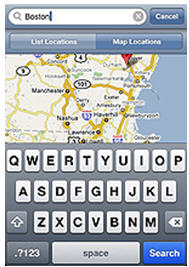
uHear uses the device's WiFi or GPS to locate hearing healthcare professionals in the area, and can provide a map
SMAKA: How long does the screening take?
HAYES: It takes about six minutes. Initially, people reported that the test took too long. What we found is that because there's no one directly testing the user, based on an individual's hearing, a person can go a long time without hearing beeps during the threshold test. Without the sense someone is in control, it can feel like a long time for the next beep to come. That's why there's a little status clock in the application telling the estimated test time so that the user has sense of how long the test will run. The Speech in Noise and Questionnaire sections are shorter;the Speech in Noise test takes about a minute and the Questionnaire takes just under two minutes.
One of the most frequently asked questions we receive is whether the pure tone test will work with noise canceling headphones. I can tell you that the application was designed to be used with two general types of earphones;inserts, resulting in a small residual volume, and over the ear headphones with larger residual volume. Any given user is not necessarily using exactly the same headphones I used in calibration. One hearing healthcare professional wanted to put large noise canceling headphones over the top of somebody's ears with earbuds underneath. This would allow a person to run the test through the earbuds while the noise canceling headphones block out environmental noise. It's kind of an interesting idea but I can't venture to say how it will affect the results as we didn't test this set up during development.
Another question asked is why the test doesn't come out exactly the same every time it is used. If you test yourself a few times in succession you can get a slightly different result each time. The first variable is the issue with calibration that I just mentioned. A second variable is room noise. During the test, the user is frequently reminded that going to a quiet room is necessary and by that, we mean as little ambient noise as possible. As you know, some very low level noise in the environment, such as that produced by a high efficiency furnace, may not even be noticed or considered to be noise by someone, but it can affect threshold testing, especially for people with normal or near normal hearing. If a person has normal hearing most likely the results will fall into the normal range, however, we're not making guarantees about where within normal range a person will fall.
SMAKA: Are there any limitations as to the degree of hearing loss that can be detected?
HAYES: Yes, it can test up to about the severe hearing loss range. The reason for this is the absolute range of the iPhone and the iPod touch devices. They have a dynamic range that's based on the current setting of the volume control, which is why uHear has the user set the volume at a specific point during each test. That means, if we test people within the normal range, then uHear can test up to about a severe hearing loss. If a person has a profound loss, the application won't come near threshold because the devices and headphones don't produce signals that loud.
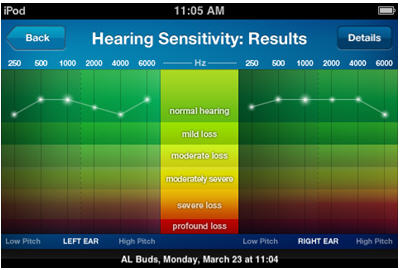
Test results are plotted on a colorful graph with hearing loss ranges indicated
SMAKA: Which part of the application - Hearing Sensitivity (threshold test), Speech in Noise, Questionnaire, or the aural rehab section - is most popular?
HAYES: Many people like the threshold test, because it's very cool and scientific. In my opinion, one of the coolest parts of this application is the Questionnaire. It's actually one of the hidden treasures within the application;it is an excellent screening tool. It is based on a questionnaire that was published in the Annals of Family Medicine in 2008 (Hidalgo et al., 2008).
SMAKA: How does uHear differ from other self-tests of hearing that are available?
HAYES: There is no comparison between our application and others that are currently available. Other applications may just be a questionnaire, or have a traditional hearing screening test where only one sound is presented and the user either hears it or doesn't. uHear is the only test on iTunes that searches for threshold. And because uHear also includes the Speech in Noise test, Questionnaire, and aural rehab sections, it is much more functional, well thought out, and much more comprehensive than anything else that's out there.
SMAKA: What are the future plans for uHear?
HAYES: Beyond getting it translated into a few other languages for international use, there are no immediate plans to make changes to the application for the moment. We're extremely pleased with uHear and the success it's achieved.
Around the time uHear launched in early May, a campaign went out to people in the industry, as well as in the mainstream media;business journals, newspapers, and the like, to try to reach a consumer audience. Now promotion is in the hands of hearing healthcare professionals and iTunes. Within the first 70 days we had already had over 54,000 downloads;the idea is to let it go viral. If someone is interested in seeing uHear, but doesn't have an iPhone or an iPod touch, there is a demonstration video on YouTube www.youtube.com/watch?v=AbJW5rLw54c and our website www.unitron.com/uhear that shows the application at work.
SMAKA: I'm going to go play with uHear on my iPhone now. I love the cool look and can't wait to try it! Don, thank you for your time today.
HAYES: Let me know how you like it! Thanks for chatting with me.
References
Hidalgo, J.L.T., Gras, C. B., Lapeira, J.M.T., Martínez, I.P., Verdejo, M.Á.L., Rabadán, F. E., and Puime, Á.O. (2008). The Hearing-Dependent daily activities scale to evaluate impact of hearing loss in older people. Annals of Family Medicine, 6, 441-447.
About Unitron
Unitron is a global innovator of technologically advanced hearing instruments. We care deeply about people with hearing loss and work closely with hearing healthcare professionals to make advanced, purpose-driven solutions available to everyone. Headquartered in Kitchener, Ontario, Canada, Unitron, a member of the Sonova Group, meets the needs of customers through 16 international offices and through distributors in a further 53 countries. For more information, please visit the Unitron at www.unitron.com


